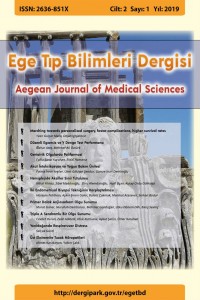Öz
Solunum zorluğu, bir bebeğin yenidoğan yoğun bakım ünitesine kabul edilmesinin en yaygın nedenlerinden biridir. Bütün dönem yenidoğanların % 7'sini etkileyen, prematürelerde daha yaygın ve yüksek oranda görülen bir durumdur. Yenidoğan yoğun bakım ünitesine başvuran bebeklerin% 15'inde ve geç preterm bebeklerin% 29'unda önemli solunum yolu morbiditesi gelişmektedir. Yenidoğanda solunum sıkıntısı, takipne, burun akıntısı, çekilme veya inleme gibi artan solunum eforunda bir veya daha fazlasında artış olarak kabul edilir. Yenidoğanda solunum sıkıntısı nedenleri çeşitli ve multisistemiktir. Pulmoner nedenler normal akciğer gelişimi veya ekstrauterin hayata geçiş sırasında değişiklikler ile ilişkili olabilir. Yenidoğanda solunum sıkıntısının altta yatan nedeni değişmektedir ve her zaman akciğer kaynaklı değildir. Bu nedenle, ilk resüsitasyon ve stabilizasyondan sonra, daha spesifik bir tanı ve uygun yönetimi
belirlemek için ayrıntılı bir öykü, fizik muayene, radyografik ve laboratuvar bulgularının kullanılması önemlidir. Yenidoğanda solunum sıkıntısını kolayca tanımayı ve çeşitli nedenlerin her biri ile ilişkili fizyolojik anormallikleri anlamayı öğrenmek optimal yönetime rehberlik edecektir..
Anahtar Kelimeler
Kaynakça
- 1. Edwards MO, Kotecha SJ, Kotecha S. Respiratory distress of the term newborn infant. Paediatr Respir Rev. 2013;14(1):29–36
- 2. Hibbard JU, Wilkins I, Sun L, et al; Consortium on Safe Labor. Respiratory morbidity in late preterm births. JAMA. 2010;304 (4):419–425
- 3.Bak SY, Shin YH, Jeon JH, et al. Prognostic factors for treatment outcomes in transient tachypnea of the newborn. Pediatr Int. 2012;54(6):875–880
- 4. Reuter S, Moser C, Baack M. Respiratory Distress in the Newborn. Pediatrics in Review. 2014;35(10):417-429
- 5. Buch M.P, Makwana A.M, ChudasamaR.K. Usefulness of Downe Score as clinical assessment tool and Bubble CPAP as primary respiratory support in neonatal respiratory distress syndrome. Journal Of Pedıatrıc Scıences. 2013;5(1);e176
- 6.Warren JB, Anderson JM. Newborn respiratory disorders. Pediatr Rev. 2010;31(12):487-495, quiz 496
- 7. West JB. Respiratory Physiology: The Essentials. Baltimore, MD: Williams & Wilkins; 2012
- 8.Magder S. Bench-to-bedside review: ventilatory abnormalities in sepsis. Crit Care. 2009;13(1):202
- 9. Weisman LE, Hansen TN. Contemporary Diagnosis andManagement of Neonatal Respiratory Diseases. 3rd ed. Newton, PA: Handbooks in Health Care Co.; 2003
- 10. Bhandari A, McGrath-Morrow S. Long-term pulmonary outcomes of patients with bronchopulmonary dysplasia. Semin Perinatol. 2013;37(2):132–137
- 11. Aly H. Respiratory disorders in the newborn: identification and diagnosis. Pediatr Rev. 2004;25(6):201–208
Öz
Respiratory distress is one of the most common causes of neonatal intensive care unit admittance. In the whole newborn period the incidence is 7%, but is becoming more common and is even more common in premature babies. Fifteen percent of babies admitted to neonatal intensive care unit and 29% of late preterm infants develop significant airway morbidity. Respiratory distress in newborn is considered as an increase in one or more following factors designating increased respiratory effort; tachypnea, runny nose, nasal flaring, retraction or grunting. The causes of respiratory distress in the newborn are diverse and multi-systemic. Pulmonary causes may be associated with changes in normal lung development or during extra uterine life. The underlying cause of respiratory distress varies in the newborn and is not always caused by respiratory system. It is therefore important to use a detailed history, physical examination, radiographic and laboratory findings to determine a more specific diagnosis and appropriate management after initial resuscitation and stabilization. Understanding respiratory distress in newborn is easy and understanding physiological abnormalities associated with each of the various causes will guide the optimal management.
Anahtar Kelimeler
Kaynakça
- 1. Edwards MO, Kotecha SJ, Kotecha S. Respiratory distress of the term newborn infant. Paediatr Respir Rev. 2013;14(1):29–36
- 2. Hibbard JU, Wilkins I, Sun L, et al; Consortium on Safe Labor. Respiratory morbidity in late preterm births. JAMA. 2010;304 (4):419–425
- 3.Bak SY, Shin YH, Jeon JH, et al. Prognostic factors for treatment outcomes in transient tachypnea of the newborn. Pediatr Int. 2012;54(6):875–880
- 4. Reuter S, Moser C, Baack M. Respiratory Distress in the Newborn. Pediatrics in Review. 2014;35(10):417-429
- 5. Buch M.P, Makwana A.M, ChudasamaR.K. Usefulness of Downe Score as clinical assessment tool and Bubble CPAP as primary respiratory support in neonatal respiratory distress syndrome. Journal Of Pedıatrıc Scıences. 2013;5(1);e176
- 6.Warren JB, Anderson JM. Newborn respiratory disorders. Pediatr Rev. 2010;31(12):487-495, quiz 496
- 7. West JB. Respiratory Physiology: The Essentials. Baltimore, MD: Williams & Wilkins; 2012
- 8.Magder S. Bench-to-bedside review: ventilatory abnormalities in sepsis. Crit Care. 2009;13(1):202
- 9. Weisman LE, Hansen TN. Contemporary Diagnosis andManagement of Neonatal Respiratory Diseases. 3rd ed. Newton, PA: Handbooks in Health Care Co.; 2003
- 10. Bhandari A, McGrath-Morrow S. Long-term pulmonary outcomes of patients with bronchopulmonary dysplasia. Semin Perinatol. 2013;37(2):132–137
- 11. Aly H. Respiratory disorders in the newborn: identification and diagnosis. Pediatr Rev. 2004;25(6):201–208
Ayrıntılar
| Birincil Dil | İngilizce |
|---|---|
| Konular | İç Hastalıkları |
| Bölüm | Derleme |
| Yazarlar | |
| Yayımlanma Tarihi | 1 Nisan 2019 |
| Kabul Tarihi | 4 Ocak 2019 |
| Yayımlandığı Sayı | Yıl 2019 Cilt: 2 Sayı: 1 |



